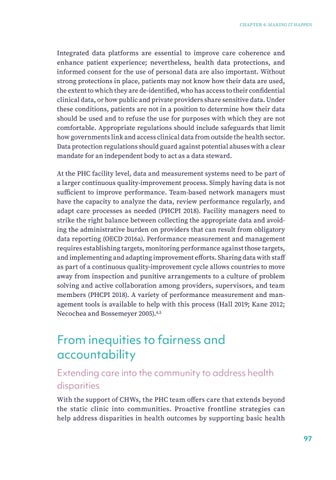CHAPTER 4: MAKING IT HAPPEN
Integrated data platforms are essential to improve care coherence and enhance patient experience; nevertheless, health data protections, and informed consent for the use of personal data are also important. Without strong protections in place, patients may not know how their data are used, the extent to which they are de-identified, who has access to their confidential clinical data, or how public and private providers share sensitive data. Under these conditions, patients are not in a position to determine how their data should be used and to refuse the use for purposes with which they are not comfortable. Appropriate regulations should include safeguards that limit how governments link and access clinical data from outside the health sector. Data protection regulations should guard against potential abuses with a clear mandate for an independent body to act as a data steward. At the PHC facility level, data and measurement systems need to be part of a larger continuous quality-improvement process. Simply having data is not sufficient to improve performance. Team-based network managers must have the capacity to analyze the data, review performance regularly, and adapt care processes as needed (PHCPI 2018). Facility managers need to strike the right balance between collecting the appropriate data and avoiding the administrative burden on providers that can result from obligatory data reporting (OECD 2016a). Performance measurement and management requires establishing targets, monitoring performance against those targets, and implementing and adapting improvement efforts. Sharing data with staff as part of a continuous quality-improvement cycle allows countries to move away from inspection and punitive arrangements to a culture of problem solving and active collaboration among providers, supervisors, and team members (PHCPI 2018). A variety of performance measurement and management tools is available to help with this process (Hall 2019; Kane 2012; Necochea and Bossemeyer 2005).4,5
From inequities to fairness and accountability Extending care into the community to address health disparities With the support of CHWs, the PHC team offers care that extends beyond the static clinic into communities. Proactive frontline strategies can help address disparities in health outcomes by supporting basic health 97


